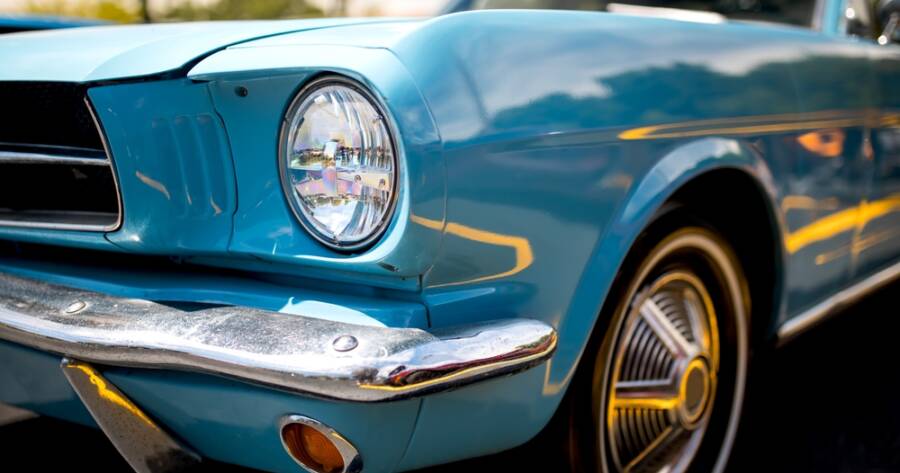Some cars do more than drive—they define eras. Whether you admired them from the sidewalk or gripped the wheel yourself, vintage vehicles have a way of sticking in memory. Each iconic model played a role in shaping automotive history, and for many, they still stir something deep in the soul.
Ford Mustang (1964½–1966)
When the Mustang hit the market in 1964, it instantly sparked a revolution. Sleek, powerful, and affordable, it appealed to a younger generation of drivers looking for something bold and fast. The Mustang’s sales soared past one million within just 18 months, forever changing how cars were designed and marketed. It wasn’t just a car—it was a cultural icon. The long hood, short deck, and galloping pony logo became symbols of American freedom. Whether you saw one parked at a diner or heard it rumble down the block, the Mustang is hard to forget.
Jaguar E-Type (1961)
Often hailed as one of the most beautiful cars ever created, the Jaguar E-Type combined British elegance with racecar speed. Even Enzo Ferrari himself called it the most beautiful car he had ever seen. With a top speed of 150 mph and a streamlined body that felt ahead of its time, it represented sophistication and thrill in one package. The E-Type wasn’t just fast—it looked fast, standing still. For those who remember it cruising down the street, its presence left a lasting impression.
Chevrolet Bel-Air (1950s)
Few cars capture 1950s Americana quite like the Chevrolet Bel-Air. Known for its chrome accents, tailfins, and two-tone paint jobs, it became a staple of the post-war boom. More than just stylish, the Bel-Air symbolized economic prosperity and suburban dreams. Families proudly parked them in driveways across the country, and the car remains a popular fixture in classic car shows today. Just one glance and you’re transported to a soda shop, a drive-in theater, or a road trip on Route 66.
Aston Martin DB5 (1964)
For many, the Aston Martin DB5 will always be James Bond’s car. Elegant yet aggressive, it was designed by Italian coachbuilder Carrozzeria Touring Superleggera and packed with style and performance. Its cinematic debut made it one of the most recognizable cars in the world, blending luxury with espionage chic. Beyond the big screen, the DB5 was a rare gem with a price that’s only skyrocketed since. If you remember spotting one, consider yourself lucky—it was automotive royalty.
Dodge Viper (1991)
Loud, raw, and unapologetically American, the Dodge Viper burst onto the scene in the early ‘90s like a shot of adrenaline. Its massive V10 engine, long hood, and muscular design made it unmistakable. Designed more for performance than comfort, the Viper was built for those who craved speed and didn’t mind taming a bit of wildness. Some loved it, others feared it—but no one ignored it. The Viper wasn’t just a car; it was a statement.
Chevrolet Camaro (1967)
Born to rival the Mustang, the Camaro quickly developed its own loyal following. With powerful engine options and a sporty stance, it became a muscle car icon. Throughout the late ’60s and beyond, the Camaro was a favorite among drag racers and gearheads alike. Its legacy lives on through decades of updated models, but the original versions hold a special place in the hearts of many. Whether in the showroom or at the track, the Camaro brought energy to the American car scene.
Ford Bronco (1966)
The original Ford Bronco wasn’t just a vehicle—it was a lifestyle choice. Built for rugged adventures and off-road trails, it became an icon for outdoor enthusiasts and surfers alike. With its removable top and boxy design, it stood out in a sea of sedans. Over time, the Bronco became more than just a utility vehicle; it grew into a beloved classic with its own fan base. For many, it represents freedom, road trips, and weekends spent far from the city.
Shelby Cobra (1962–1967)
The Shelby Cobra was a beast wrapped in beauty. Combining a lightweight British chassis with a big American V8, Carroll Shelby’s creation delivered unmatched performance and style. It was lightning-quick and looked the part too, with its wide stance and unmistakable curves. Original models are exceedingly rare today, making them some of the most sought-after collectibles in the classic car world. Anyone who remembers seeing a real Cobra on the street remembers something truly special.
Lincoln Continental (1961–1965)
With its distinctive suicide doors and clean, understated design, the Lincoln Continental brought elegance to American roads. Unlike the flashier Cadillacs of its time, the Continental exuded confidence through simplicity. It became the official vehicle of presidents and celebrities alike, reinforcing its status as a symbol of class. Even today, the Continental’s unique design influences modern luxury cars. It’s hard to forget the first time you saw those rear-hinged doors swing open.
Lamborghini Miura (1966)
The Lamborghini Miura changed the game. Often considered the world’s first supercar, it stunned with its low-slung body, mid-engine layout, and exotic presence. Every detail screamed performance and exclusivity. With limited production numbers and aggressive styling, the Miura stood out from anything else on the road. It wasn’t just a car—it was a dream on wheels. If you ever heard the roar of its engine or caught a glimpse of its silhouette, you knew you were witnessing greatness.
Moments That Never Fade
Old cars aren’t just machines; they’re memories in motion. They remind us of family road trips, high school parking lots, first loves, and simpler times. Each vehicle on this list helped shape a generation and continues to inspire passion today. Whether you remember driving one or simply admiring from afar, their legacy is impossible to forget. Keep exploring, and you might just rediscover an old favorite on the road again.

